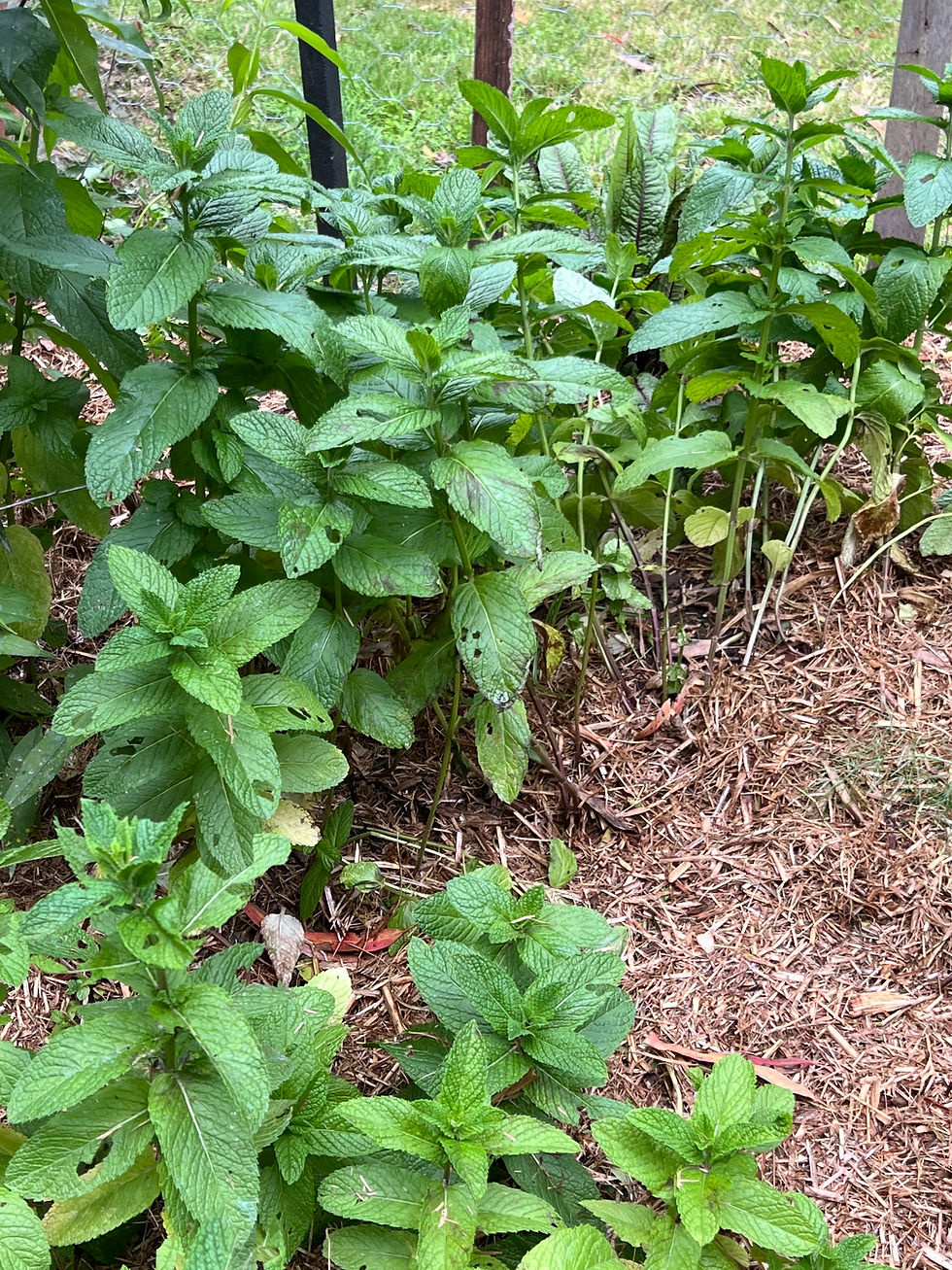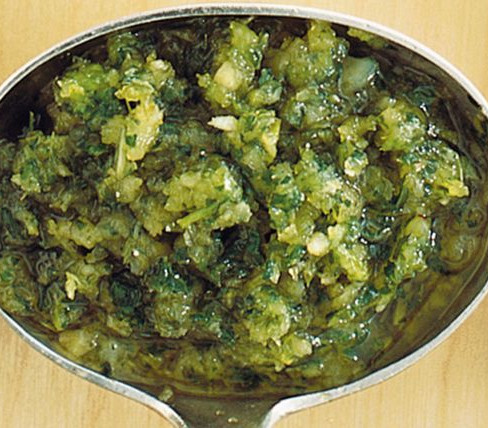Mint sauce(s)
- rosemary
- Dec 5, 2022
- 6 min read
"when done right, mint sauce is the key to turning casual summer dinners into something special." Salon.com

I spent the morning weeding my veggie patch and generally tidying it up. The weeding included pulling up large quantities of mint which is beginning to take at least half of it over. This is just some of what is left, and yes, I know it doesn't look that healthy, but that's because I don't trim it enough. Believe me there is plenty there.
So much that I don't really know what to do with it. Today it was wet, and so I did not do what I had thought to do - make bunches of it and leave it in the street library - there is a space for fresh stuff there. So what I pulled up just went into the compost. But I really need to find something to do with it.
My first thought was mint sauce of course. Well I am British after all. But honestly how often do we have roast lamb in this house? Maybe twice a year. It's expensive and anyway there are only two of us. You need a crowd for roast lamb. It would keep though at least for a while, although I suspect that the taste would deteriorate over time.

The mint sauce that we had growing up looked a bit like this. It came from the shop, as a jar of concentrated mint sauce which was then 'watered down' with vinegar - malt vinegar. Actually most of the mint sauce you buy has already gone through that process with just a few mint leaves at the bottom of a jar of vinegary mix. Elizabeth David, who did not 'care for mint sauce' nevertheless has a recipe in her Spices, Salt and Aromatics in the English Kitchen book but ends it with the comment that:
"a less good idea is the brown vinegar. White wine vinegar is less savage and it makes the sauce more acceptable, even if less authentically English. And a quarter pint of any vinegar does seem to me rather too much."
Jane Grigson is equally forthright:
"The first point is not to be mean with the mint. The second is to use boiling water, which releases the fragrance of the mint into the sauce. The third is to avoid malt vinegar, which is harsh and can ruin any wine which is being served."
As to mint jelly:
"Mint jellies which try to hold this pleasure for winter eating, I find disgusting, because they are too sweet, too green."

Hear, hear to that.
But you can make mint sauce, and I have, although I confess I was not that pleased. But then I was following the traditional recipes which have you pouring boiling water over the chopped mint before adding vinegar - quite a bit - and some sugar - Elizabeth David recommends brown.
These days, however, any mint sauce recipe you find on the net will give you something looking much more like this one, although having just checked out this recipe I see that it is actually pretty traditional - it even uses malt vinegar. But it is so much thicker than the traditional ones. All to the good I think. Some people these days add some olive oil to the mix which makes it creamier and I'm also guessing that a fair few of them are blended together, not just left to mix itself. This Summer mint sauce from Salon.com is perhaps the best example of this kind of thing - a modern version of the traditional - there are all sorts of modern additions - olive oil, lemon, red pepper flakes, honey ...

It's interesting that traditional recipes are so stingy with the mint, because there's hardly ever a shortage of it. It's a weed fundamentally and will take over your garden in no time. Hugh Fearnley-Whittingstall said it was the first herb he would give to people as a gift because you couldn't kill it. True - I can kill anything, but not mint.

I suspect that basic roast lamb with mint sauce is a dying thing. Mint is still very often used with lamb but not in that traditional way. Nigel Slater is a fan though:
"a traditional clear mint sauce made with vinegar and the merest pinch of sugar with a roast shoulder is almost worth doing just to watch the food snobs' hackles rise. I love it, and would argue it is just perfect with peas and new potatoes." Nigel Slater
And yes, it certainly looks good here - a leg not a shoulder, but still sort of the same.
Origins - I saw somebody say that it went back as far as the Romans, someone else said that it was medieval and also that Queen Elizabeth I of England decreed that mutton could only be eaten with bitter herbs as a way to dissuade commoners from eating it, thus preserving the wool trade. And apparently that didn't work. The French think it's weird - but then they don't really do mint. Which is also weird.
For two reasons I thought that I would look for other kinds of mint sauces. The first reason is that I have all this mint and it would be good to find a sauce or something similar that would keep for ages and would use heaps of mint. I failed there. The second is that I thought that traditional mint sauce is disappearing because it's been replaced with other minty kind of sauces.

First there is Sauce Paloise which is a kind of Sauce Béarnaise, but flavoured with mint rather than tarragon. I first came across this many, many years ago in a Robert Carrier recipe - now lost - for lamb chops with Sauce Palouse. It was delicious. Nigel Slater likes this kind of buttery, creamy sauce as well although he seems to prefer a Hollandaise version - Grilled lamb cutlets with mint butter sauce:
"Mint with lamb is often frowned upon by some of the more up-themselves foodies, and yet I can think of few more pleasing extras to serve on the side of a trio of lamb cutlets than a hollandaise sauce into which you have stirred freshly mashed mint leaves."
Give it a go sometime anyway.
Then there are the Middle-Eastern versions which mix the mint with yoghurt or tahini. Sometimes the mint is dried, sometimes it's a bit of dried and fresh. Really the recipes are endless - everyone has their favourite, but I suppose the three main varieties are a straight mint and yoghurt mix, a mint and tahini/yoghurt mix and tsatziki - which includes cucumber. Here are a few examples: Nigel Slater's Spiced lamb with mint and cucumber yoghurt; and his
Fennel radish and mint - which had sour cream in the mix; tzatziki - this version is from Love and Lemons; and Bon Appétit's The greenest tahini sauce. Marinade, dip, base, sauce, drizzle - infinitely variable.

Early on in my 'researches' i found that Georgia has it's own unique mint sauce called Mint adjika which is a mix of mint, garlic and chillies. There was no picture of my original source recipe so I found another one from a website called 177 Milk Street.
"People in western Georgia keep a jar of adjika in their fridge to mix through stretchy cheese when making elardji, and it goes well with creamy fresh cheeses, such as in the fruit and dairy toast recipe that follows. Brush a smidgen on to some sourdough toast topped with good mozzarella. Alternatively, stir it through boiled new potatoes." Olia Hercules
Moving further east we come to India and Thailand, both of which have mint based sauces - Mint chutney - the stuff you get served with your parathas in an Indian restaurant; Mint raita - the Indian version of tzatziki perhaps - a cooling side dish anyway - both of these are from a website called Sawsthi's Kitchen; and - not cooling at all - Thai chile mint dipping sauce from Epicurious.
In south and central America we get Mint Chimichurri from Simply Recipes; and from a book called Tacolicious, featured on the Serious Eats website there is Roasted tomato mint salsa - just one example of a vast range of mint based salsas.
Back home, as it were, although inspired by Italy we have Mint and almond pesto - how could I ignore pesto? and from Ozzie Woolworths - Lamb shoulder with fresh mint salsa verde
I have a feeling that there is a vast range of other mint based sauces, but put 'mint sauces' into Google and all you get is the traditional British kind. Well almost. My apologies to all those other nationalities that have something wonderful that I have missed.
I do like mint and obviously shall be using it a lot in the near future. Though it does die down a bit in summer. It doesn't really like heat and no water. Shade and water are what it loves.
I'll end with this rather nice origin story for the word itself:
"Its name comes from Minthe, the nymph who so captivated Pluto that his jealous wife, Proserpina, transformed her into lowly, humble mint, destined for ever to creep along the ground. Well, Pluto's loss was our gain, and ever since we've been enraptured by her fresh, fragrant, saucy charms." Hugh Fearnley-Whittingstall


























Comments